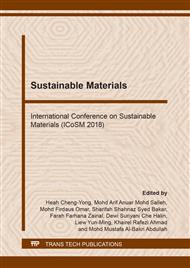[1]
M. A. A. Mohd Salleh, C. M. Gourlay, J. W. Xian, S. A. Belyakov, H. Yasuda, S. D. McDonald and K. Nogita, Scientific Reports Vol 7, Article number: 40010, (2017).
Google Scholar
[2]
S.A. Musa, M.A.A Mohd Salleh and N. Saud: Advan. Mater. Res. Vol 795, (2013), pp.518-521.
Google Scholar
[3]
M.A.A Mohd Salleh, S.D. McDonald and K. Nogita: App. Mech. Mater. Vol 421, (2013) pp.260-266.
Google Scholar
[4]
T. Xin: China Population, Resour. Environ. Vol 17, (2007), pp.66-77.
Google Scholar
[5]
M.A.A Mohd Salleh, S.D. McDonald, Y.Terada and K.Nogita: Mater. & Design. Vol 82, (2015), pp.136-147.
Google Scholar
[6]
W.R. Osório, L.C. Peixoto, L.R. Garcia, N. Mangelinck-Noël and A. Garcia: J. Alloys Comp. Vol 572, (2013), pp.97-106.
DOI: 10.1016/j.jallcom.2013.03.234
Google Scholar
[7]
Y.C. Chan and D. Yang: Prog. Mater. Sci. Vol 55, (2010), p.428–475.
Google Scholar
[8]
M. Abtew and G. Selvaduray: Mater. Sci. Eng. R. 271, (2000), p.95–141.
Google Scholar
[9]
M.A.A Mohd Salleh, M.H. Zan@Hazizi, Z.A. Ahmad, K. Hussin and K.R. Ahmad: Advan. Materi. Res. Vol 277, (2011), pp.106-111.
Google Scholar
[10]
K.N. Tu, H.-Y. Hsiao and C. Chen: Microelectron. Reliab. Vol 53, (2013), p.2–6.
Google Scholar
[11]
F. Wang, X. Ma and Y. Qian: Scripta Mater. Vol 53, (2005), p.699–702.
Google Scholar
[12]
M.G. Cho, S.K. Kang, S.-K. Seo, D.-Y. Shih and H.M. Lee: J. Electron. Mater. Vol 38, (2009), p.2242–2250.
Google Scholar
[13]
G. Melcioiu, V.A. Serban, M. Ashworth, C. Codrean, M. Li ̧ta ̆ and G.D. Wilcox: in Solid State Phenomena, (Trans Tech Publication 2014).
Google Scholar
[14]
E. Iver, A. Boesenberg, J. Harringa, D. Riegner, A. Steinmetz and D. Hillman: J. Electron. Mater. Vol 41, (2012), p.390–397.
Google Scholar
[15]
H. Ye, S. Xue and M. Pecht: J. Mater. Res. Vol 27, (2012), p.1887–1894.
Google Scholar
[16]
M.S. Park and R. Arro ́yave: Acta Mater. Vol 60, (2012), p.923–934.
Google Scholar
[17]
H. Lin, C. Lu, C. Liu, C. Chen, D. Chen, J.-C. Kuo and K.N. Tu: Acta Mater. Vol 61, (2013), p.4910–4919.
Google Scholar
[18]
J. Koo, J. Chang, Y.W. Lee, S.J. Hong, K.-S. Kim and H.M. Lee: J. Alloys Compd. Vol 608, (2014) p.126–132.
Google Scholar
[19]
L. Yang, Y. Zhang, J. Dai, Y. Jing, J. Ge and N. Zhang: Mater. Des. Vol 67, (2015), p.209–216.
Google Scholar
[20]
J. Shen, Y. Pu, D. Wu, Q. Tang and M. Zhao: J. Mater. Sci. Mater. Electron. Vol 26, (2015), p.1572–1580.
Google Scholar
[21]
F. Somidin, M.A.A. Salleh and K. Rafezi, Advan. Mater. Res. Vol 620, (2013), pp.105-111.
Google Scholar
[22]
D.X. Luo, S.B. Xue and Z.Q. Li: J Mater Sci: Mater. Electron. Vol 25, (2014) p.3566–3571.
Google Scholar
[23]
H.J. Caul, D.L. Smith and J. Am. Dent. Assoc. Vol 53, (1956), p.3–315.
Google Scholar
[24]
T.C. Hsuan and K.L. Lin: J. Alloys Compd. Vol 409, (2009), p.350.
Google Scholar
[25]
K.I. Chen and K.L. Lin: J. Electron. Mater. Vol 32, (2003)
, p.10–1111.
Google Scholar
[26]
K.I. Chen, S.C. Cheng, C.H. Cheng, S. Wu, Y.L. Jiang and T.C. Cheng: Adv. Mater. Sci. Eng. 2014, 1 (2014).
Google Scholar
[27]
W.X. Chen, S.B Xui, H. Wang, J.X Wang, Z.J. Han and J. Mater Sci: Mater Electron. Vol 21, (2010) p.496–502.
Google Scholar
[28]
G. Zeng, Stuart D. McDonald, D. Mu, Y. Terada, H. Yasuda, Q. Gu, M.A.A. Mohd Salleh and K. Nogita: J. Alloys Comp, Vol 685, (2016), pp.471-482.
Google Scholar
[29]
H.W. Wang, J.S. Fang, Z.Q. Xu and X.P. Zhang: J. Mater Sci: Mater Electron. Vol 26 (2015) p.3589–3595.
Google Scholar
[30]
Q.K. Zhang, W.M. Long, X.Q. Yu, Y.Y. Pei and P.X. Qiao: J. Alloys Compd. Vol 622, (2015), p.973–978.
Google Scholar


